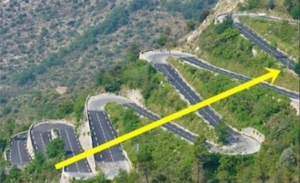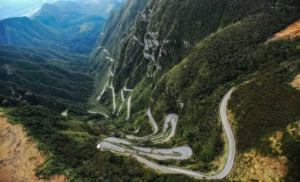When driving through mountainous areas, you’ve probably noticed roads that twist and turn instead of going straight up. At first glance, it might seem that building a road in a straight line would be quicker and more cost-effective. However, there are several important reasons why engineers opt for the zigzag or winding path when constructing roads up steep slopes.
The Science Behind Zigzag Roads

The fundamental reason for building roads with curves rather than straight lines has to do with safety and practicality. A straight road may seem like the fastest way up a mountain, but in reality, it would be far more dangerous and difficult to navigate. Let’s take a closer look at why zigzag roads are the preferred choice.
Gradual Incline vs. Steep Slopes
One of the primary reasons zigzag roads are used is to reduce the steepness of the incline. If a road were built straight up a mountain, the angle of ascent would be too steep for most vehicles to handle safely. A steep, direct path would also require more power from vehicles, making it challenging for drivers to maintain control, especially in adverse weather conditions like rain or snow. By designing roads with curves, the incline is more gradual, making it easier for vehicles to ascend and descend without straining their engines or brakes.
Preserving Driver Focus
Another key factor in designing winding roads is to help drivers maintain focus. Believe it or not, driving up a steep, straight road for long periods can cause drivers to lose concentration. When roads are designed with curves, drivers are forced to pay attention to their steering, keeping them more alert and engaged with the task of driving. The regular twists and turns also break up the monotony of the drive, making it safer overall.
Historical Insights: Following Nature’s Path
In the past, when people needed to create paths up mountains, they would often follow the natural routes taken by animals like donkeys. These animals instinctively avoided steep, direct paths in favor of routes with gentler inclines, which were easier to climb. Engineers have taken inspiration from these natural trails, using them as the foundation for modern road designs. The paths that animals and humans have historically used tend to be winding, further reinforcing the idea that zigzag roads are more practical for mountainous terrain.
Safety Concerns: Reducing Speed on Steep Roads
Curved roads also play a critical role in regulating the speed of vehicles. On steep, straight roads, vehicles can easily pick up dangerous speeds, especially during descent. This can increase the risk of accidents, particularly if the driver loses control of the vehicle. Zigzag roads naturally force drivers to slow down as they navigate the curves, making the overall journey safer. The curves act as a natural speed control mechanism, preventing vehicles from accelerating too quickly.
Environmental Considerations
When building roads through mountainous or hilly areas, environmental impact is always a concern. A straight road would require more extensive excavation, which could damage the natural landscape and lead to issues like erosion. In contrast, winding roads can be built with fewer disruptions to the environment. Engineers can work with the natural contours of the land, preserving ecosystems and reducing the amount of land that needs to be disturbed during construction.
Engineering Efficiency: Saving Costs in the Long Run

While it might seem counterintuitive, zigzag roads can actually be more cost-effective in the long run. Constructing a straight road up a steep slope would require more advanced construction techniques, stronger materials, and additional safety measures to prevent accidents. The cost of maintaining such a road would also be higher, as steep roads are more prone to wear and tear from both vehicles and weather conditions. By opting for a winding road with a gradual incline, engineers can reduce the overall cost of construction and maintenance, while also ensuring the road remains safe and functional for years to come.
Conclusion: Why Straight Isn’t Always Better
In the end, building a road straight up a mountain might seem like a shortcut, but it would actually create more problems than it solves. From a safety, environmental, and cost perspective, winding roads are far superior. They reduce the steepness of the incline, keep drivers focused, prevent dangerous speeds, and minimize environmental damage. So next time you find yourself driving along a zigzag road, remember—there’s a good reason why it’s not a straight path to the top.